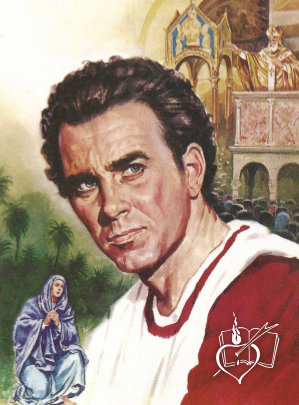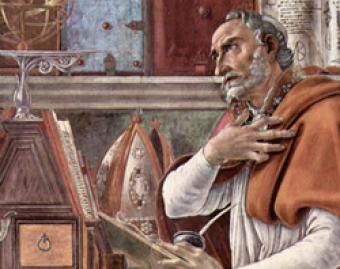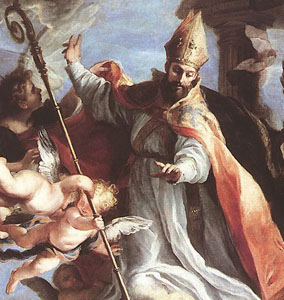
Summary: St Augustine, born at Tagaste (Algeria) in 354; died at Hippo (Tunisia) in 430: baptised in 387, together with his son, after a long inner struggle and under the influence of St Ambrose (Feast:7 Dec.) and the prayers of his mother, Saint Monica (c/f 27 August). Bishop, Doctor of the Church. He taught in Carthage, Rome, and Milan.Bishop of Hippo for thirty-four years. Lived a communal life with his clergy and served the many needs of his people at a time of political and cultural collapse. Honoured as a model pastor and as a preacher and writer whose thought has had an enduring influence in Christian history.
Patrick Duffy tells his story.
 A Berber with Roman citizenship
A Berber with Roman citizenship
Augustine, a Roman African, was born in 354 in Tagaste, North Africa, (in present-day Algeria) to a pagan father named Patricius and a Christian mother named Monica. He may have been a Berber by race but his family name, Aurelius, suggests his family had Roman citizenship from the Edict of Caracalla in 212.
Teenage Years: Latin Literature and Hedonistic Lifestyle
At 11, Augustine was sent to school at Madaurus, a Roman colony, also in present-day Algeria, where he became familiar with Latin literature, came home for two years and then went to study rhetoric in Carthage (in present-day Tunisia). At Carthage he got into a hedonistic lifestyle.
“I came to Carthage, and all around me in my ears were the activities of impure loves. I was not yet in love, but I loved the idea of love” (Confessions 3:51). He began a relationship that lasted thirteen years with a young woman whom he never names: she became his concubine. “It was a sweet thing to be loved, and more sweet still when I was able to enjoy the body of a woman” (Confessions 3:51).
Teaching Grammar and Rhetoric at Tagaste, Carthage, Rome and Milan
After teaching grammar at Tagaste (373-4), Augustine moved to Carthage where he conducted a school of rhetoric for the next nine years (374-383) and then went to Rome. where an introduction to the prefect of the City of Rome, Symmachus, eventually secured him the post of professor of rhetoric at the imperial court at Milan in 384. Although he was interested in Manichaeism, this began to change at Milan, where he became interested in Neoplatonism. Augustine lived for fifteen years with a woman who remains unknown and with whom he had a son, named Adeodatus who died when he was about eighteen.
His mother Monica had followed him to Cartage, persuaded him to put away his concubine and was pressuring him to become a Christian. But it was the bishop of Milan, Ambrose, who had most influence over Augustine. Ambrose was a master of rhetoric like Augustine himself, but older and more experienced.
Conversion

Augustine, the convert who changed Church history
This quotation from the beginning of the Confessions of Saint Augustine sums up the intellectual and spiritual journey of this extraordinary man. “You have made us for yourself, O Lord and our heart is restless until it rests in you.“
He was influenced by reading the life of Saint Anthony of the Desert, who when he read “Go, sell all you have, and give to the poor, and come and follow me”, did just that. While experiencing the pulls and tugs of this crisis, Augustine was sitting one day in a garden and heard the voice of a child repeating a chant: Tolle, lege! Tolle, lege! “Take up and read! Take up and read!” Interpreted this as a call from God to take up the Bible, he did so and read from the passage in Romans 13:13-14: “Let us live decently as people do in the daytime: no drunken orgies, no promiscuity or licentiousness, and no wrangling or jealousy. Let your armour be the Lord Jesus Christ; forget about satisfying your bodies with all their cravings.” He did not need to read any further. A light of serenity pierced his darkness and all doubt melted away from him (Confessions 8:29).
Baptism and Return to Africa
Augustine then formed a lay community near Milan at Cassiciacum. His friend Alypius whom he knew from Tagaste was also a member and both along with Adeodatus were baptised by Ambrose at Easter 387. In August 387 Alypius was in the company of Augustine, Monica, Adeodatus, Navigius (the brother of Augustine) and Evodius (a North African companion) when they travelled to the port of Ostia with the intention of sailing back to North Africa to establish a lay community at Tagaste. Monica, however, died at Ostia on the way and was buried there.

Bishop Augustine
Bishop of Hippo
Augustine and Alypius lived a community life for a while at Tagaste (388-391). His friend Possidius, who later wrote a life of Augustine, was also a member of that community and later bishop of Calama. But this community life ended unexpectedly when Augustine was pressed into priesthood by the aging bishop and community at Hippo. Five years later he became bishop of Hippo. Alypius too became a priest and became bishop of Tagaste, where he remained till his death in 430. Augustine lived a monastic or community life at the episcopal residence in Hippo.
Synods, Sermons, Writings, and Letters
The next thirty years were turbulent for the Church: the Vandals were destroying the Latin culture; the city of Rome was losing its influence; and there were controversies with the heresies of Donatism and Pelagianism in the Church of North Africa. Bishop Augustine spent a lot of time attending synods and meetings of bishops in Carthage and other cities of North Africa. He also wrote many letters both within and outside Africa. The range of his writings is vast: the two best known works are his Confessions, an account of his own path to God and The City of God, which was occasioned by the fall of Rome to Alaric and the Visigoths in 410. But there are also Expositions on the Psalms, and works On the Trinity, On Grace and Free Will, On Original Sin and a host of others.
Death
Augustine was seventy-six when the Vandals came through Gaul and Spain to North Africa and were at the gate of the city of Hippo as he lay dying inside and they took it over as their capital after he died. His mortal remains were taken first to Sardinia and then to Pavia in Lombardy, northern Italy, where they can still be seen today. Along with Saints Jerome, Ambrose, and Gregory the Great he is regarded as one of the four doctors of the Western Church.
Influence
The vastness of his theological work and the fact that it was catalogued and preserved has meant that every generation of Christian thinking has been able to be in dialogue with the issues he treated right up to the present day.
Pope Benedict XVI, who in 1953 wrote his doctoral thesis on “The People and the House of God in Augustine’s Doctrine of the Church”, dedicated three catecheses on Augustine and his spirituality at his Wednesday audiences in January 2008 that are well worth reading.
__________________________
******************************
Memorable Proverb for Today
The man of faith who has never experienced doubt
is not a man of faith.
******************************